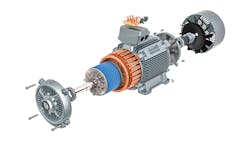Motors and drives become smaller, more powerful and more efficient
Industry is pushing motors and drives to be smaller and more powerful, as well as more efficient. Supply-chain disruptions have impacted the current market, but the demand for ease of use, customization and integration will continue to shape the market moving forward. Six manufacturers—Festo, Kollmorgen, Nidec, Schneider Electric, Allied Motion Technologies and Bosch Rexroth—have foreseen these trends and are working toward fulfilling machine builders’ and end users’ needs.
Ease of use
Product market manager of electric automation for Festo
“The most important trend I’m seeing is ease of use. Everyone is used to consumer technology that is intuitive or that guides you through the setup process,” says Tom Worsnopp, product market manager of electric automation for Festo. “Two examples of this are smartphones and smart TVs. There is some basic setup when you first get the device, and then it pretty much works as you expect it to. No need to ever read the manual. Neither of those devices started that way. And neither is perfect, even now. But more people expect to have an easy experience with technology. Servo drives still aren’t there yet, so moving in that direction is going to be a winning strategy for companies.”
Compact drives
Product line manager for Kollmorgen
“Smaller, lighter components are key to applications such as mobile robots and portable medical equipment,” says Will Hulbert, product line manager for Kollmorgen. “This has put pressure on suppliers to develop more compact drives that deliver the same amount or more power in less space, as well as precise movement control.
“Drive-resident safety features that provide safe stop, safe speed and safe positioning—in addition to the standard safe torque off (STO)—are also in increasing demand. Safety functions have become integral to making machines that meet higher safety protection requirements up to SIL3/Ple. By integrating safety features in the drive, suppliers make it easier for machine builders to navigate what can be a complex and expensive process,” Hulbert adds.
Regional Director for Control Techniques, UK and Ireland for Nidec
Dedicated drives
“A continuing trend is the expansion of dedicated drives for specific applications,” says Gareth D. Jones, regional director for Control Techniques, UK and Ireland for Nidec. “Typical examples of this are drives for water and wastewater pumping, HVAC, elevators and cranes. These drives give customers the confidence that they will do the job and will tend to have optimized hardware, drive firmware and documentation that will be designed to fit in with the units and technical terms used within that application, such as a pump drive that is configured in psi rather than rpm.”
Component integration
Product market manager for electric automation for Festo
“Many OEM machine builders are tasked with developing smaller, faster and smarter machines to support growth in new automation markets, such as the booming logistics and material-handling markets being fueled by increased ecommerce sales,” says Eric Rice, product market manager for electric automation for Festo. “Along with those requirements, the development time for new machinery is becoming compressed as end users expect to implement new designs in a matter of months instead of years. These trends are causing OEMs to look for motor and drive solutions that simplify the design process for them, such as those that integrate an increasing number of hardware and software functions into a single solution. Examples are motors with integrated drive and control electronics onboard—integrated motors—drives with built-in functional safety features such as safe-torque off (STO), and drives with onboard industrial Ethernet for direct connections to the machine network. The increasing number of integrated features in motor and drive solutions allow machine builders to accomplish more with a single axis than ever before.”
Inverter technology demand
Senior offer manager for drives for Schneider Electric
“The basic performance of ac drives is consistent, but the applications and opportunities for them is growing rapidly,” says David Chen, senior offer manager for drives for Schneider Electric. “By adding IIoT connectivity, these devices provide greater control, safer operation and increased process efficiency, reducing operating costs and energy use.
“Customers are looking for solutions that are more versatile and easier to use in their industrial devices. We are also seeing an increasing number of applications where VFDs can provide benefits as people are becoming more familiar with inverter technology. Add in the increased control and efficiency that modern VFDs provide, and we expect this increase in demand for VFDs to continue,” Chen adds.
Robotics technology
Senior marketing analyst at Allied Motion Technologies
“Robotics are already being used in distribution centers and large industrial halls, but in the long term they will likely be used on public roads, as well,” says Mike Wright, senior marketing analyst at Allied Motion Technologies. “Think of semi-autonomous vehicles. Robotics will completely change the transport sector, with positive effects on road safety, efficiency and environmental impact. Smart, green and integrated transport is one of the challenges defined by Europe, in which robotics can make an important contribution in the sector. Typical logistics applications require better interaction technology and 3D environment interpretation.
Product manager of automation and electrification for Bosch Rexroth
“Fewer people work in agriculture so the yield per square meter must increase to meet global food needs. Around the world, there has been an increase in the number of companies showing interest in the development and deployment of driverless tractors, cow milking systems and robots for various processes like harvesting, pruning, weeding, pick-and-place, aerial observation or drones, sorting, seeding, spraying and materials handling by integrating advanced sensors, hardware, networking and high-precision localization technologies. Farmers believe that farm robots could provide relief from labor shortages, reduce costs, increase quality, quantity and safety, and yield a more consistent product,” Wright adds.
Flexible machines
“Customers are asking to have flexible machines—for example, machines that can quickly adapt to various products, smaller lot sizes, and even the ability to create a unique customer-specific product. Servo drives and servo motors are used for this trend,” says Joaquin Ocampo, product manager of automation and electrification for Bosch Rexroth.
Motor and drive market challenges
Overwhelmingly, manufacturers identified supply chain issues as the No. 1 overwhelming challenge for new motor and drive design.
- Machine learning: “Customers have come to expect their devices to be smart devices. They are helpful, but they are not really pushing the industry forward. The company that can harness machine learning into the VFD—taking real-time performance data and adjusting a process based on that information—will win the market,” says Chen of Schneider Electric.
- Integrated functionality: “To meet the increasing variety of customer applications, motor and drive products will continue along the path of integration with more functionality included in the axis. Eventually a motor will be able to connect to the network, automatically configure itself for operation, and begin doing work in a very short time, regardless of the network protocol and with very little operator interaction,” says Rice of Festo.
- Ease of use: “Going back to ease of use, I think this is going to be a distinguishing factor in the future. Companies that have intuitive interfaces for servo-drive setup are going to have an advantage. And for the same reason, we’re probably going to see more demand for integrated motors, where the servo drive is integrated into the motor housing. Integrated motors are great at reducing setup time. The cables are easier to connect to the motor, they don’t require a servo drive in the cabinet, and there are fewer components to order—an all-around easier product to use,” says Worsnopp of Festo.
- Green electrification: “The threat or realization of global warming is revolutionizing our energy industries, and we will see wholesale shifts from fossil fuel-based sources to greener technologies. Here drives, in the form of bulk power converters, are playing a major role in facilitating new technologies. Greening of the global economy will accelerate adoption for energy transition, optimization, electrification, and recovery of waste energy applied from a micro to massive scale,” says Jones of Nidec.
- More customization: “Future trends include further integration of high-efficiency motor parts, delivering power on demand, in the smallest envelope possible and higher demand for custom solutions, optimized for precision applications, particularly in medical and robotic applications,” says Wright of Allied.
- Limited materials: “In 2021, the biggest challenge facing the market is supply-chain limitations. Between limited microprocessors, plastics and metals, all of which are used in servo drives and motors, the shortages are creating problems for many servo-drive manufacturers,” says Worsnopp of Festo.
- Availability across international lines: “While the servo-motors-and-drives market is expected to enjoy continued growth through 2025, labor shortages and supply chain disruption have the potential to derail some of the gains,” says Hulbert of Kollmorgen. “The COVID-19 pandemic has impacted supply chains and the availability and movement of labor across international lines. Training personnel to operate higher-tech equipment is also a challenge in some industry segments, which may slow the adoption of robots, AGVs, and other advanced technology. Suppliers can mitigate the effects of market slowdowns by producing more feature-rich drives that offer maximum flexibility at an affordable cost. AC servo drives do not have brushes or commutators, which keep maintenance and replacement costs down. Developing low-voltage options that improve energy efficiency is another way suppliers can keep their products attractive to OEMs.”
- Supplier communication and flexibility: “There is increasing competition from Asia, which can deliver a similar product at much lower costs. They are developing fast in terms of technology. Whether customers will adopt these products depends mainly on the quality of the product and the reliability of the supplier. Additionally, the communication and flexibility of these suppliers will determine whether they become a real threat to U.S. companies,” says Wright of Allied. “End users are increasingly demanding sustainable products and the government is imposing stricter sustainability requirements. For the industry it is time to take a serious look at new energy-saving solutions that are or will be offered by manufacturers and suppliers within the energy transition currently or in the near future.”
- Increased technology demands: “With the rapidly increasing demands for automation and digitalization across all industry segments, machine builders are increasingly being tasked with new functional requirements from end users,” says Festo’s Rice. “Compounding this is the global shortage of raw materials and semi-finished goods.”
Influence of IIoT
With the Industrial Internet of Things (IIoT) in automation, openness is becoming more of a standard, rather than the exception. “The growth of IIoT demands more connectivity and flexibility from every component, including drives,” says Kollmorgen’s Hulbert. “Machine builders are grappling with how IIoT can help improve their products and value proposition to their customers. OEMs want drive products that work in both standard and custom configurations, seamlessly communicating with multiple networks and systems.”
The more that motors and drives can communicate with all communication protocols, the faster IIoT with be implemented in automation applications. “The rapid pace of digitalization in manufacturing means that motors and drives need to speak directly to other components on the machine,” says Festo’s Rice. “Because end users make the final decision on which networking protocols will be used on their manufacturing floor, the onus to provide machinery that works with those protocols falls on machine builders. Motor and drive suppliers with support for the widest range of networking options—including Profinet, EtherCAT, EtherNet/IP, Modbus, IO-Link and MQTT—are able to offer OEM machine builders an advantage when faced with varying network requirements from end users. A common motor and drive range that works the same across any industrial Ethernet network makes the product-selection process much simpler for those OEMs.”
Making the data in the servo drives easily available to the customer’s cloud can be an important outcome of Industry 4.0 efforts, and there are two pieces to accomplish this, explains Festo’s Worsnopp. “The first is making it possible to share data, and this requires a so-called edge device, which takes the data from devices and shares it with the customer’s server. The other piece is making the data available at the device level. Servo drives can share information about motor torque and speed, which is useful for customers who want to use this kind of information for preventive maintenance. For example, if motor torque increases over time, that could indicate additional friction in the actuator, signaling it needs servicing.”
IIoT isn’t just for the most advanced operation. Connecting with important drive data can push older facilities into Industry 4.0 standards. “The connectivity and data reporting from modern VFDs is providing much greater insight into machines and processes,” says Schneider Electric’s Chen. “By adding a modern VFD, users are able to extract a great deal of operational information that wasn’t available before. There is always room for improvement and modernization, but this one addition can help bring an older operation into the IIoT Age and provide new levels of transparency for users.”
About the Author
Anna Townshend
Managing Editor
Anna Townshend has been a writer and journalist for 20 years. Previously, she was the editor of Marina Dock Age and International Dredging Review, until she joined Endeavor Business Media in June 2020. She is the managing editor of Control Design and Plant Services.

Leaders relevant to this article:








